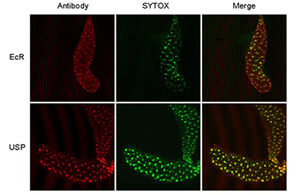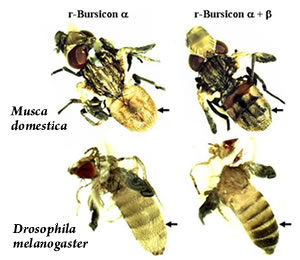Transformation of an insect from larva to adult, i.e. molting and metamorphosis, is a miracle of biology. Molting and metamorphosis provide insect with an ability to adapt to total different environmental conditions at different stages of its life cycle and is the main reason for the great success of insects on this planet. The molting process is initiated by molting hormone, mainly 20 hydroxyecdysone (20E), and ended up with cuticle sclerotization, regulated by a neuropeptide hormone bursicon. The research interests of my laboratory are mainly focused on molecular mechanisms of 20E and bursicon actions.

Figure 1: Immocytochemical localization of EcR and USP in the salivary glands of early wandering larvae of Drosiphila melanogaster. The salivary glands were immunostained with EcR or USP mAb (red color) and then counterstained with SYTOX Green nucleic acid stain (green color). EcR and USP signals were visualized using confocal microscope (BioRad Radiance 2000) at MU Cytology Core.
Specifically, we are investigating the roles of protein kinases in mediating 20E induced gene expression. Using biochemical, molecular and proteomic approaches, we have shown that PKC regulates the phosphorylation of ecdysone receptor (EcR) and its heterodimer partner ultraspiracle protein (USP), thus mediating 20E-induced gene expression that leads to molting and metamorphosis in insects. After each molt, insect cuticle is soft and vulnerable. It must be sclerotized (hardened and darkened) within a short period of time in order for insect to survive the danger of desiccation, pathogens and predators. Bursicon is a neuropeptide that regulates cuticle sclerotization and wing expansion in insects. We are particularly interested in elucidating bursicon signal transduction pathway and the genes that are regulated by bursicon. Using recombinant bursicon and DNA microarray, we have identified a set of bursicon regulated genes in Drosophila and are in the process of revealing bursicon signaling components. Elucidation of the mechanisms that regulate insect molting and cuticle sclerotization would provide information not only for understanding the principles of insect growth and development, but also for designing more efficient control agents for insect pest control.

Figure 2: Effects of the PKC-specific inhibitor chelerythrine chloride (CC) on EcR (a) and USP (b) subcellular localization in the salivary glands of Drosophila melanogaster.

Figure 3: Functional assay of the recombinant bursicon (r-bursicon) in neck-ligated flies. Newly emerged flies were neck-ligated at emergence. These flies with unsclerotized cuticle at one hour after ligation were injected with 0.5 µl of the purified r-bursicon α (a,b) or r-bursicon heterodimer (c,d) expressed in mammalian 293 cells. Arrow indicates the area with the unsclerotized cuticle (light colored) in control (a,b) and the sclerotized cuticle (darkened) in the animals injected with r-bursicon heterodimer (c,d).
